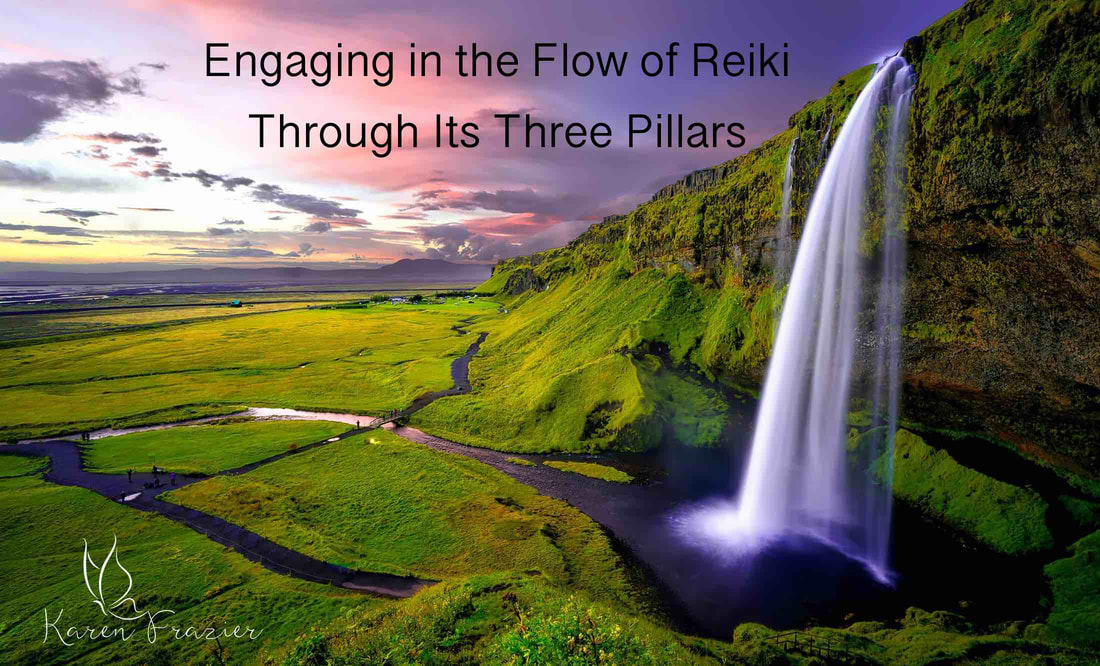|
Being mindful during a Reiki session can create a more meaningful and intentional healing experience for both the Reiki practitioner and his or her healing partner. In his teachings, Dr. Mikao Usui taught practitioners three foundational practices that he called the three pillars of Reiki, gassho, reiji-ho, and chiryo. Each of these practices has multiple purposes, and all are equally necessary during a Reiki healing session. Purposes of the three pillars include:
-Serving as a source of spiritual hygiene to put the Reiki practitioner into a calm and centered state of mind before and during channeling Reiki -Allowing the practitioner's ego to step aside and allow intuitive information from the Reiki energy, her healing partner, and Divine Guidance -Connecting the practitioner and his healing partner to the Reiki energy -Allowing the practitioner to work more intuitively as she channels Reiki energy to her healing partner -Creating an "envelope" of mindfulness for the session for both the practitioner and his healing partner The First Pillar: Gassho The first pillar of Reiki, gassho, is more than a meditative practice. It also serves as a form of spiritual hygiene, a ritual to create intention and focus, an invitation to mindfulness, a call to set aside ego, and the primary method to invite and ignite Reiki healing energy within a session. While gassho is primarily taught in Western forms of Reiki as a meditative practice that entails holding one's hands in prayer position and focusing on where the middle fingertips meet, it is far more involved and deeper than these simple instructions indicate. During gassho, while the fingertips serve as a physical focal point to help the Reiki practitioner remain mindful and in the moment, a skilled practitioner combines the mindfulness of gassho with breath work and intention. As Spiritual Hygiene As spiritual hygiene, Reiki practitioners should engage in gassho for 5 to 10 minutes before every session in order to purify not only the energy of the space in which the sacred sharing of the Reiki energy will occur, but also to enter into a state of mindfulness where he or she is open to Reiki energy and positive guidance. This is especially important for practitioners who live "normal" lives between sessions (and don't we all?) where the needs of the world often intrude on upon our ideal spiritual state of being. Before every session, perform any energy work in your healing space you normally do as part of your pre-game ritual, whether that involves burning herbs, drawing symbols in the space, or any other space clearing ritual. Next, sit comfortably in the space in gassho. Concentrate on your breathing and the space where your middle fingertips meet. Feel Reiki forming in the air around you and breathe it in, allowing it to flow in through your nose and lungs and throughout your entire body. Exhale tension or anything from your day that does serve you nor not belong in your session. Do this for as long as it takes. Some days, it may only take five minutes, but on those other days where the world has intruded, it may take longer. Do this until you are calm, peaceful, centered, and out of your ego. Only then should you invite your healing partner into your healing space. To Set Intention and Invite and Ignite Reiki Energy Once you have invited your healing partner into the appropriately prepared space, consulted with them as needed, and they are resting comfortably on your treatment table, stand at your partner's head or feet and enter into gassho again. This time, do so focusing on any intention for the session you and your healing partner have agreed upon along with the intention to serve the highest and greatest good. Once again, feel the Reiki gather around you. Breathe it in, and invite it to flow through you and into your hands. When you feel your hands ignite, you can begin your session. To Return to Mindfulness or Seek Guidance Throughout your session, you can return to gassho any time you feel the need. Gassho is your safe space where you can return to mindfulness, refocus or reset intention, or receive guidance about where to place your hands on your healing partner. It is the form within the freedom of an intuitive Reiki session. If you feel your mind start to drift or notice your energy shift, return to gassho. If you feel unsure about what to do next, return to gassho. Walk to your partner's head or feet again and stand in gassho until you feel refocused. If you need, ask for guidance and then pay attention. A thought may come into your head, a part of your healing partner's body may "light up" in your gaze, or you may just feel drawn to a certain area. Go with this flow. Return to gassho whenever you need to recenter, wish to return to mindfulness if the outside world starts to intrude on your session, or feel unsure of what to do next. To Give Thanks and Return to Yourself You can also return to gassho at the close of a session. When you feel ready, move to your healing partner's feet and stand in gassho. Give thanks to Reiki and to your partner for allowing you to channel the energy to serve the highest and greatest good. Then, invite your energy to return to you and see the energetic connection between you and your partner releasing. When you feel ready, run your hands under cool water or touch the ground to ground yourself. The Second Pillar: Reiji-Ho Gassho is interwoven throughout the other two pillars of Reiki. Reiji-ho, the second pillar, is all about asking for guidance. While First Degree Reiki practitioners learn the Reiki hand positions, as they progress they may begin to feel comfortable enough to work intuitively. I encourage my students entering Second Degree Reiki to begin working intuitively as often as possible during Reiki sessions knowing if they need to, they can always return to the hand positions. In reiji-ho, you invite guidance in. It begins in gassho, with your hands held in prayer position asking to have your hands and energy guided to serve the highest and greatest good of your healing partner. And then, you wait and you use all of your senses to listen. Listen to how your body feels, what your mind thinks, what your eyes see, and how your healing partner responds. As you wait for guidance, observe with all of your senses and allow your mind to empty so it becomes a vessel into which guidance can flow easily. You will learn over time how your Divine Guidance signals you. You may spot a twitch. You may feel something in your own body. You may hear instructions in your mind. You may feel as if you are magnetically drawn to somewhere on your healing partner's body. There is no wrong way to receive information. Reiji-ho takes trust in yourself, your healing partner, your Divine Guidance system, Reiki, and the universe. It also requires mindfulness. It requires you to allow yourself to be energetically open in order to become a vessel the universe uses to serve the highest and greatest good. When you receive a signal, trust it, act on it, and know the Reiki energy will flow exactly where and as it is needed for the highest and greatest good. When you feel yourself slipping out of that space as a vessel and a channel and back into your own personal stuff, return to gassho and re-set yourself. The Third Pillar: Chiryo The third pillar of Reiki, chiryo, is all about action. Chiryo means "treatment," and it is an essential part of every Reiki session. New Reiki practitioners focus primarily on chiryo, following the mechanical process of placing hands on the body in set positions and trusting the Reiki will flow where it's needed. However, as a practitioner becomes more deeply involved in the true practice of Reiki, chiryo is something that flows and changes depending on intuitive information the Reiki practitioner receives and the needs of his or her healing partner. A practitioner truly engaged in chiryo moves beyond the basic hand positions and sometimes even moves beyond use of the hands. He or she may be intuitively guided to gaze, tap, stroke, blow, or visualize along with placing hands, palms, or fingertips in the ways they are guided to do so. In this way, a mindful session of Reiki becomes a flowing dance of energy that involves the practitioner, his or her healing partner, and the entire universe. Image by David Mark from Pixabay
4 Comments
Michelle McFerrin
7/27/2019 07:43:56 am
I found this article to not only be helpful , but necessary in order to be a part of my Reiki. I was never taught this at first or second level. I will be using it from now on and if permissible, give it to my friends that are practitioners also. Thanks SO MUCH!!!
Reply
Veronica
11/8/2020 03:33:12 am
Thank you It makes so much sense and helped me And confirmed for me .🙏🏻
Reply
Leave a Reply. |
Categories
All
Archives
December 2022
|
AUTHOR KAREN FRAZIER
- Home
-
Books
- Angel Numbers for Beginners
- Avalanche of Spirits
- Chakra Crystals
- Complete Reiki
- Crystal Alchemist
- Crystals for Beginners
- Crystals for Healing
- Dancing with the Afterlife
- Dream Interpretation Handbook
- Essential Crystal Meditation
- Higher Vibes Toolbox
- Introduction to Crystal Grids
- Little Book of Energy Healing Techniques
- Noisy Ghosts
- Reiki Healing for Beginners
- Transform Your Life with Alchemy
- Ultimate Guide to Psychic Ability
- Usui Ryoho Reiki Manual
- Cookbooks
- Other Books
- Classes
- Connect
- Meditate

 RSS Feed
RSS Feed
